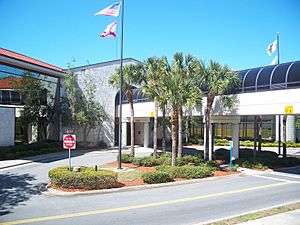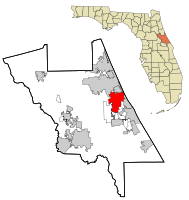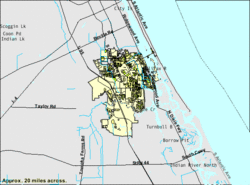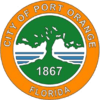Port Orange, Florida facts for kids
Quick facts for kids
Port Orange, Florida
|
|||
|---|---|---|---|

Port Orange City Hall
|
|||
|
|||

Location in Volusia County and the state of Florida
|
|||

U.S. Census Bureau map showing city limits
|
|||
| Country | |||
| State | |||
| County | Volusia | ||
| Incorporated | April 26, 1867 | ||
| Government | |||
| • Type | Council-Manager | ||
| Area | |||
| • City | 28.86 sq mi (74.74 km2) | ||
| • Land | 26.83 sq mi (69.49 km2) | ||
| • Water | 2.03 sq mi (5.25 km2) 7.1% | ||
| Elevation | 3 ft (0.9 m) | ||
| Population
(2020)
|
|||
| • City | 62,596 | ||
| • Density | 2,332.97/sq mi (900.76/km2) | ||
| • Metro | 494,593 | ||
| Time zone | UTC-5 (EST) | ||
| • Summer (DST) | UTC-4 (EDT) | ||
| ZIP codes |
32123, 32127-32129
|
||
| Area code(s) | 386 | ||
| FIPS code | 12-58575 | ||
| GNIS feature ID | 0295559 | ||
| Website | http://www.port-orange.org | ||
Port Orange is a city located in Volusia County, Florida, in the United States. It's part of a larger area called the Deltona–Daytona Beach–Ormond Beach metropolitan area. Port Orange is also a main city in the "Fun Coast" region of Florida. In 2020, about 62,596 people lived here.
The city was first settled by John Milton Hawks. After the U.S. Civil War, he brought formerly enslaved African Americans to work at his sawmill. Esther Hawks also started a school in the area that welcomed all students. The first settlement faced many challenges, and most people eventually left. However, the area known as Freemanville is a reminder of the settlers who stayed.
Contents
Geography and Climate
Port Orange is located at about 29.118970 degrees North and -81.002906 degrees West.
The United States Census Bureau says the city covers about 74.3 square kilometers (28.7 square miles) in total. Most of this area, about 69.0 square kilometers (26.6 square miles), is land. The rest, about 5.3 square kilometers (2.0 square miles), is water.
The weather in Port Orange is usually hot and humid in the summer. Winters are generally mild. This type of weather is called a humid subtropical climate.
Population and People
| Historical population | |||
|---|---|---|---|
| Census | Pop. | %± | |
| 1920 | 380 | — | |
| 1930 | 678 | 78.4% | |
| 1940 | 662 | −2.4% | |
| 1950 | 1,201 | 81.4% | |
| 1960 | 1,801 | 50.0% | |
| 1970 | 3,781 | 109.9% | |
| 1980 | 18,756 | 396.1% | |
| 1990 | 35,317 | 88.3% | |
| 2000 | 45,823 | 29.7% | |
| 2010 | 56,048 | 22.3% | |
| 2020 | 62,596 | 11.7% | |
| U.S. Decennial Census | |||
In 2020, there were 62,596 people living in Port Orange. These people made up 26,547 households, with 16,244 of them being families.
In 2010, the city had 56,048 people living in 23,447 households, with 14,977 families.
Economy and Jobs
One of the bigger companies in Port Orange is Thompson Pump and Manufacturing, which makes pumps. The city is also trying to attract more high-tech companies. For example, Raydon Corporation, a company that creates simulation training for defense, moved its main office and all its work here in 2010.
Education and Schools
The Volusia County Schools system manages all the public elementary, middle, and high schools in Port Orange. The schools in Port Orange are highly rated by the state. One of the high schools, Spruce Creek High School, has been named one of the top 100 high schools in the country many times. It also offers a special program called the International Baccalaureate.
Elementary Schools
- Horizon Elementary School
- Spruce Creek Elementary School
- Sugar Mill Elementary School
- Cypress Creek Elementary School
- Sweetwater Elementary School
- Port Orange Elementary School
- South Daytona Elementary School
Middle Schools
- Creekside Middle School
- Silver Sands Middle School
- Campbell Middle School
- David C. Hinson Sr. Middle School
- Deland Middle School
- Deltona Middle School
- Galaxy Middle School
- Heritage Middle School
- Holly Hill Middle School
- New Smyrna Beach Middle School
- Ormond Beach Middle School
- River Springs Middle School
- Southwestern Middle School
- T. Dewitt Taylor Middle-High
High Schools
- Spruce Creek High School
- Atlantic High School
- Deland High School
- Deltona High School
- Mainland High School
- New Smyrna Beach High School
- Pine Ridge High School
- Seabreeze High School
- University High School
- T. Dewitt Taylor Middle-High
Colleges and Universities
Port Orange is home to the Florida campus of Palmer College of Chiropractic. This campus was started in 2002.
Culture and Fun
The Kenneth W. Parker Amphitheater is a place where many events happen. One popular event is the yearly Lakeside Jazz Festival.
Famous People from Port Orange
Many well-known people have lived in Port Orange, including:
- Vince Carter, a famous NBA basketball player
- Adam Cianciarulo, a professional Motocross racer
- Marci Gonzalez, an ABC news reporter
- Danielle Harris, an actress
- Ryan Lochte, an Olympic gold medalist in swimming
- Bobby Kennedy, a NASCAR driver
- Mark Martin, a NASCAR driver
- Dan Pardus, a NASCAR driver
- Mike Skinner, a NASCAR driver
Getting Around Port Orange
Airports
- The Daytona Beach International Airport is the closest large airport.
- New Smyrna Beach Municipal Airport is a smaller airport very close to Port Orange.
- Spruce Creek Airport is a private airport for a community.
Main Roads
- Interstate 95 (I-95) is a major highway that runs north and south along the east coast of Florida. The only exit for Port Orange is Exit 256, which connects to Florida State Road 421.
- U.S. Route 1 (US 1), also known as Ridgewood Avenue, is the main local road that goes through Port Orange from north to south. It used to be the main highway in the area before I-95 was built.
- State Road A1A is known as the Port Orange Causeway and South Atlantic Avenue.
- State Road 5A is also called Nova Road.
- State Road 421 is known as Taylor Road and Dunlawton Avenue.
- State Road 441 is called South Peninsula Drive.
Railroad
The main railroad line that goes through Port Orange is the Florida East Coast Railway. In the past, Port Orange had separate stations for passengers and freight. Passenger train service stopped in 1932, and freight service ended in 1964. Today, freight trains still use the railway, but they do not stop in Port Orange.
Public Transportation
Port Orange has several bus routes run by VOTRAN. Routes #4 and #17 offer service on Sundays and at night.
See also
 In Spanish: Port Orange para niños
In Spanish: Port Orange para niños



